The expression "Chinese chess cards" is commonly used to indicate
a particular variety of decks used in China and in South-Eastern Asia, whose subjects feature
the same characters of chessmen in the board game of XiangQi
(or Jeung Chi in Cantonese), whose
meaning is "elephant chess", but is more commonly referred to as Chinese Chess.
XiangQi is very popular in Hong Kong and China; with slight differences
it is also enjoyed in Korea. The games played with the chess cards, though, have barely
any relation at all with the board game: the characters used for
indicating the ranks are the only point in common. |
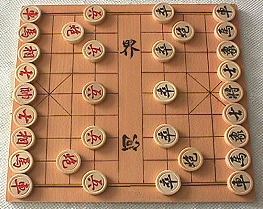 |

two Generals and two Horses,
from different XiangQi sets |
The classic board game uses 36 circular pieces, similar to Western draughtsmen,
each piece carved and/or painted on one side with the Chinese character corresponding to
the rank: one General, two Mandarins (or Dignitaries), two Ministers (or Elephants),
two Chariots, two Horses (or Knights), two Cannons and five
Soldiers (or Pawns). Some pieces on the two opposing sides have a different
spelling, as shown in the following table, although how many
different ones are used may change from edition to edition.
|

the seven subjects of XiangQi

FOUR COLOUR CARDS
This pattern, whose original name is Si Se Pai
("four colour cards"), contains a much larger number of cards than XianQi's chessmen. In fact,
there are 112 subjects, divided by colour into four groups, or suits: yellow, red, green and
white. For each colour, the seven characters are repeated four times (i.e. four Generals,
four Ministers, four Soldiers, etc.), making a total of 28 cards per set.
Si Se Pai cards are produced in two main varieties, whose sizes are different: a short
type, measuring about 2 x 5 cm. (¾ x 2 inches)
and a long one, slightly more narrow but whose length is almost double (i.e. thin and long).
Both of them are referred to according to the colour of their backs. |

a long Si Se Pai deck by
"Double Fish" Brand (Hong Kong);
General and Cannon · General and Minister
General and Horse · General and Chariot
|

BLACK BACK FOUR COLOUR CARDS
(LONG TYPE)
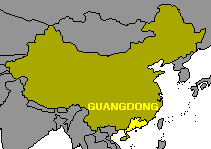 |
The name in full means black back Chao Zhou
four colour cards, referring to a town in the province of GuangDong
(southern China). In fact, the specification "black back" is sometimes dropped, being
the geographic reference enough to identify this variety.
Its features, besides the thin shape of the cards and the colour of the backs, are as
follows: |
 |
- the cards have rounded ends;
- the same seven Chinese characters are used in all four suits (or colours);
- the white suit has characters printed in red;
- the central part of the card has either the name or the logo of the manufacturer.

LIGHT BROWN FOUR COLOUR CARDS
(SHORT TYPE)

samples from a short Si Se Pai deck, by
"Beautiful Women" Brand (Hong Kong):
General and Cannon · General and Minister
General and Horse · General and Chariot
note the different spelling of the
General (first card of each couple) |
The name of the short variety with light brown backs may differ
from edition to edition, because it specifically refers to the shade of the colour: the literal
meaning of the two names above are "melon yellow back four colour cards" (ranging between
deep beige and pale orange) and "bitter orange tree red back four colour cards" (more or
less light tawny).
Their features are: |
 |
- cards with sharp corners;
- some characters used in the yellow and red suits differ from the ones used in the
green and white suits;
- the white cards have characters printed in black, as any other suit;
- the central part of the card is filled with a decorative motif, usually a Chinese
character without any relation with the card's rank (for instance, the one shown by
all the Generals reads "happiness").
|
Sometimes both varieties are given no specification at all, simply mentioned as "four
colour cards".
Among the games played with these cards is Si Se Pai (same name as the deck),
fully described in Wei-Hwa Huang's page,
not very different from Mah Jong.
Another game for which the four colour cards are used is Ju Jiuu
( "Nine Chariots"); this is a gambling game in which players receive two
cards each from a "banker", and after having placed a bet they try to get as close as
possible to a score of 9. This game shows an evident resemblance with the Japanese game
of Kabu, and a number of well-known Western games, such as Black Jack and
Baccarat.
The Chao Zhou four colour variety (i.e. the long one) is also found in many Southern Asian
countries reached by Chinese immigrants, such as Thailand, Malaysia, etc.; such editions are identical to the ones made
in China (see picture on the right).
Instead, some of these countries also use variants of the short (or brown back) variety made
of 56 cards, i.e. half the standard number, see the relevant Southeast
Asian gallery. |
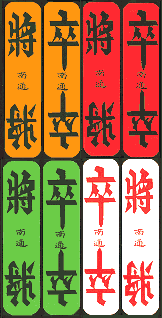
long Si Se Pai made in
Belgium, for export to Malaysia |
A few "long" editions may include a number of extra subjects, as a further element of
gamble in play. These cards feature human figures, often as allegories of traditional
blessings, and similar elements of luck, which Chinese card players are very fond of.
The edition shown below has five of these extra subjects: gong ("duke", the lowest),
hou ("marquis"), bo ("count"), zi ("earl"), nan ("barron", the highest),
which are the five hierarchic nobility ranks of ancient China.

long Si Se Pai
by Tien Yuen company, China |
It also differs from most other long versions because many features match the short type,
such as the use of alternative characters in the different suit colours, the print in black on
the white cards, etc.
|
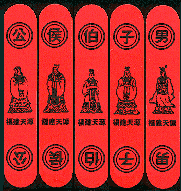
the five extra subjects
of the edition shown on the left: |

edition by "Double Elephant", Hong Kong:
the card on the left is the Emperor (General),
then Minister, Cannon, Horse and Soldier |
|
A fewer number of chess card editions only have two colours,
or suits. They are known as JuMaPao ("chariot, horse, cannon",
the name of the game played with them).
The two opposing sides are red and black. These colours are the
same ones used for the foreground print, i.e. the illustrations, while the
background is white in both suits. In some editions the red side is replaced by white.
Also in this kind of pattern the rank is shown in Chinese on both
ends of the card, and different characters are used for the same subjects
(see picture on the left). Sometimes small figures referring to the character (the General,
the Minister, etc.), are featured in the central space, otherwise filled only with the
manufacturer's logo or name.
These two colour cards may considerably vary in graphic style from edition to edition,
as no standard scheme apparently exists.
Due to a heterogenous composition of the pattern, also the number of cards in the deck may
vary. In some editions each rank is repeated the same number of times.
In others, instead, both colours have a higher number of Soldier cards, the lowest rank.
Lastly, most editions also have additional honours or "specials", usually featuring a
character for "gold".
|
|
The edition shown above has 132 cards, with subjects repeated eight times, ten
soldiers on each side, and no specials. The highest card on each side is decorated more richly than
others, and is labelled "Emperor" (in place of the usual General).
Another sample of this pattern can be seen in the
Thai gallery.
Modern editions exist in Western-sized format, as well. In these cases, the central
part of the card always has a picture of the subject, while the relevant Chinese character
is featured in the corners, as an index.
The sample shown on the right comes from a deck
that contains 32 cards, with two of each subject except the General,
which is single, and the Soldiers,
duplicated five times.
|
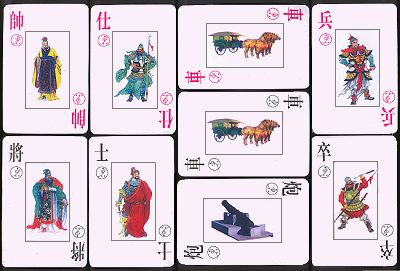
General, Mandarin, Chariot, Cannon and Soldier
(manufactured in China) |